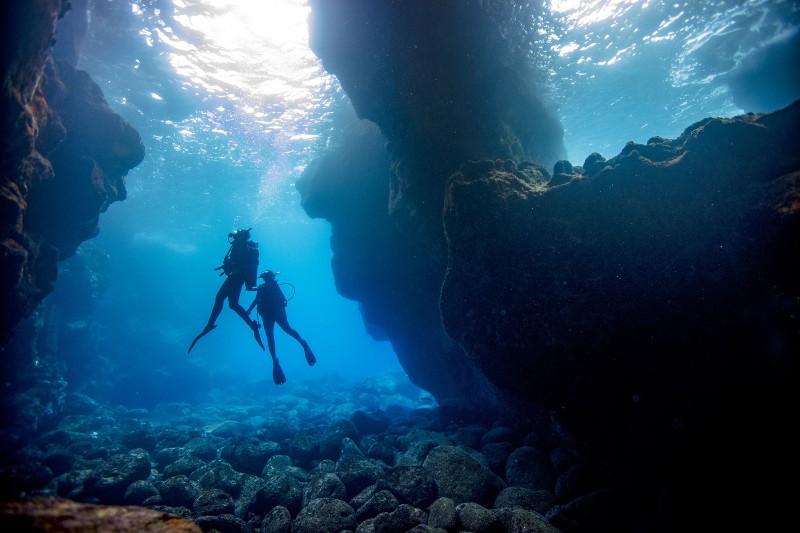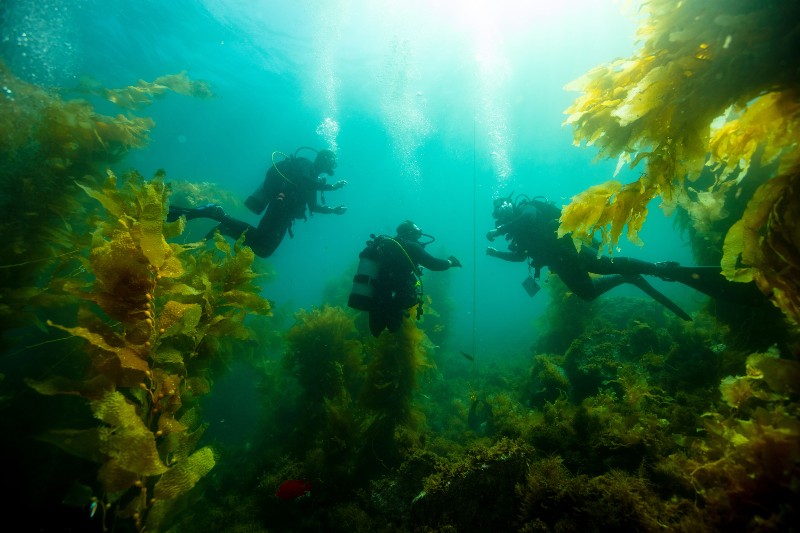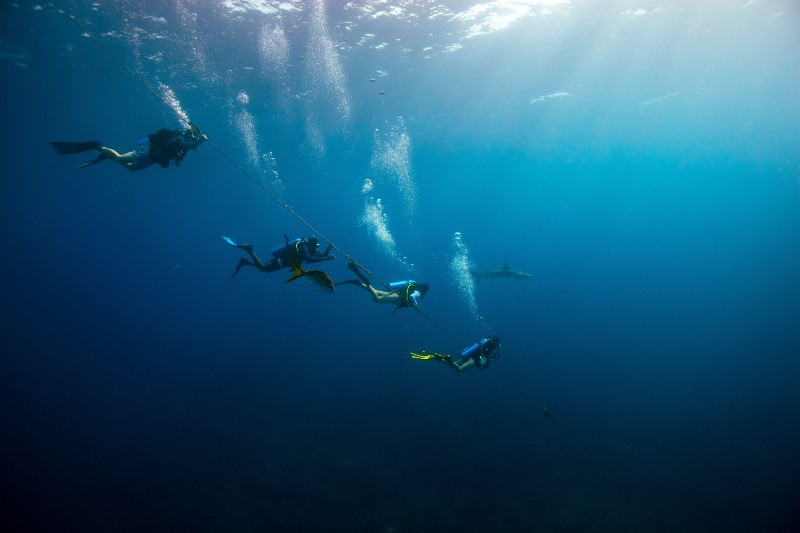
Winter may not seem like an ideal time for a subaquatic adventure, but throughout the United States, there are diving destinations that are especially spectacular during the winter. From inland locations to wildlife-rich springs, to warm coastal waters, there are winter destinations for divers of all skill levels scattered throughout the United States. And for beginners considering a trip, PADI (Professional Association of Diving Instructors), the world’s largest organization of divers and ocean explorers, also offers the opportunity to start learning online through PADI eLearning, with courses including open-water diving, dry-suit diving, and ice diving.
“You may not think of scuba diving during the winter but it’s a fantastic time to seek adventure beneath the surface. Cooler waters bring crystal clear visibility awe-inspiring shark aggregations and unforgettable marine mammal interactions,” says Kristin Valette Wirth, Chief Brand and Membership Officer for PADI Worldwide, “Throughout the United States, there are waters waiting to be explored, including local shores, lakes, rivers, and even freshwater springs.”
A PADI Master Scuba Diver Trainer with more than 30 years of experience in the diving industry, including as the manager of a dive center in Santa Barbara, Valette Wirth says, ‘Proper gear and training is key to enjoyable winter diving — as is a knowledgeable local PADI dive operation. Regardless of where you decide to dive this winter,’ she adds ‘you can start preparing for your trip at home with PADI eLearning. That way, you can spend more time beneath the surface when you reach your actual destination.’
Flower Garden Banks National Marine Sanctuary, Texas

Situated off the coast of Texas and Louisiana in the subtropical waters of the Gulf of Mexico, the Flower Garden Banks National Marine Sanctuary protects a chain of biodiversity-rich reefs and banks, discovered by mariners pursing grouper and snapper. Embedded with more than 20 different species of hard corals, including mammoth brain and star coral, the protected area’s underwater habitat draws a wide array of marine life, including toothy barracudas, massive manta rays, and endangered whale sharks. During the winter, the 160 square mile sanctuary also becomes a hub for eagle rays and massive swarms of scalloped hammerheads. In the Gulf of Mexico, the critically-endangered hammerheads gather in large groups consisting entirely of male sharks and appear every year between January and March — although the reason for the seasonal schooling remains a mystery.
“Their numbers are often in the hundreds in this National Marine Sanctuary,” says Valette Wirth, “and the best way to experience this incredible seasonal highlight is to head out on a PADI dive liveaboard.”
Homestead Crater, Utah

Diving doesn’t always have to mean a trip to the coast. In Utah, just outside Park City, the geothermal waters of the Homestead Crater make the ancient hot springs an inviting winter dive spot. Encapsulated in a hive-shaped limestone dome, the spring-fed crater plunges to depths of 65 feet — and water temperatures consistently hover around 95 degrees, all year long. While there may not be marine life lurking in the crater, there are plenty of subaquatic features to explore in the mineral-rich water — and the geothermal spring is also used as an open-water dive site for scuba certification. Now part of the Homestead Resort, the cavernous crater is easily accessible to swimmers, divers, snorkelers, and paddleboarders year-round.
“If you love diving and skiing as much as I do, Homestead Crater is the perfect destination,’ Valette Wirth says, ‘It is only a 20-minute drive from the skiing nirvana that is Park City, providing a contrasting warm-watered dive to the snowy slopes nearby.”
Read more: 6 Best Diving Sites for Beginners and Pros Alike
Crystal River, Florida

Despite their hulking bodies, Florida manatees can’t handle cold water. During the winner, when temperatures dip in the Gulf of Mexico, the beefy marine mammals seek out water temperatures above 68 degrees — often heading inland to slow-moving rivers and crystalline springs. One of the best places in the Sunshine State to spot manatees is Kings Bay and the Crystal River. A superhighway for heat-seeking manatees, the 7-mile Crystal River extends from the Gulf of Mexico to 600 acre Kings Bay, the second-largest springs group in the state. Between Kings Bay and the Crystal River, a patchwork of preserves protects the migratory manatees, including the Crystal River National Wildlife Refuge. And, for inexperienced divers, only a mask and snorkel are needed to explore the waters of the Crystal River — and the refuge also provides a handy set of guidelines for respecting the protected area’s roving manatees.
“There is nothing more incredible than Crystal River in Florida in the winter,” says Valette Wirth. “As a protected marine mammal, Crystal River is the only place you can legally with manatees. Their numbers can be in the hundreds and they are incredibly friendly. Of course, I kept my distance,” she adds, “but these gentle giants often choose to interact with you.”
Catalina Island, California

The southernmost of California’s Channel Islands, Catalina Island is an ecologically-rich atoll with a colorful history. Just off the coast of Southern California, the island has served as the location for a wide assortment of Hollywood films and even hosted the Chicago Cubs for spring training after being purchased by gum mogul William Wrigley Jr in 1919. Today, most of the island, including 62 miles of coastline, is protected by the non-profit Catalina Island Conservancy. Offshore, the waters surrounding Catalina Island are teeming with dense kelp forests and rocky reefs, protected by a conglomeration of marine conservation areas. One of the most accessible spots for shore divers is the Casino Point State Marine Conservation Area. Frequented by gargantuan black sea bass, bat rays, California sea lions, the year-round dive site also features water temperatures that stay above 55 degrees during the winter.
“Aside from the expansive kelp forests, divers will likely find horn sharks, giant seabass, sea urchins, spiny lobsters, seals, and more. Recently, I had the honor of teaching my 13-year-old daughter to dive here, and I watched her discover the wonder and beauty of the underwater world — just as I had,” Valette Wirth adds.
Jupiter, Florida

Along Florida’s Atlantic Coast about 90 miles north of Miami, the town of Jupiter is a hub for winter diving. The seaside town provides easy access to an array of coastal parks with nearshore reefs ideal for snorkelers and shore divers, including Carlin Park and Dubois Park. However, further offshore, the waters off the coast of Jupiter are renowned for hosting hordes of lemon sharks, efficient predators that can grow up 10 feet in size. The migrating sharks typically gather between December and March, drawn in part by the Gulf Stream, a powerful ocean current that cycles warmer water from the Gulf of Mexico into the Atlantic Ocean, creating an ecosystem rich in nutrients for marine life.
“Congregating in groups of 15 to 50, divers can drift with shivers of these iconic sharks that hover above wrecks like the 147-foot Esso Bonaire,” says Valette Wirth, “and thanks to the Gulf Stream current, the water temperature sits at a comfortable 70 degrees this time of year.”




